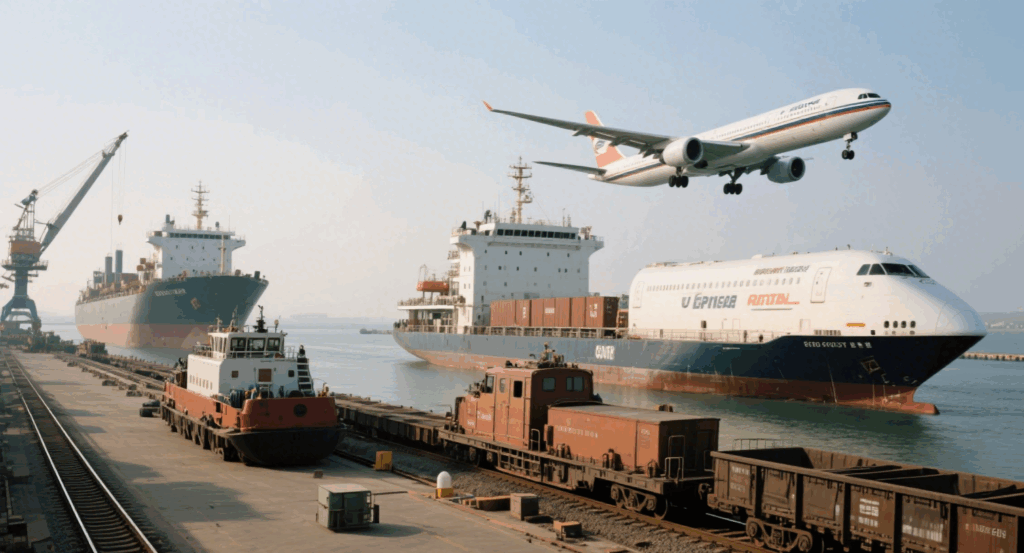International trade depends heavily on China, the world’s largest exporter of manufactured goods. Importers dealing with electronics, textiles, furniture, and machinery often ask: how much are the freight charges from China? However, the answer is not straightforward. Costs vary depending on the shipping mode, distance, cargo type, and customs requirements. Detailed quotation can be consulted TJ china Freight.Moreover, seasonal demand, fuel prices, and global trade conditions can further influence rates. This guide explains container pricing, air freight costs, customs documentation, and strategies to lower expenses with real-world examples.
What Are the Main Shipping Methods from China?
| Method | Average Cost | Transit Time | Pros | Cons |
|---|---|---|---|---|
| Sea Freight | 20GP $1,000–$1,500 / 40HQ $1,800–$2,500 | 25–40 days | Cheapest for bulk cargo | Slower than other methods |
| Air Freight | $5.50–$9.00 per kg | 3–7 days | Fast, reliable, best for urgent shipments | Expensive for heavy cargo |
| Courier | $7–$12 per kg | 3–6 days | Door-to-door, simple for parcels | Limited cargo size |
| Rail Freight | $3.50–$5.50 per kg | 15–22 days | Balanced cost and speed (China–Europe) | Limited global coverage |
Accordingly, most bulk goods move by sea, while air and courier dominate e-commerce and high-value sectors.
How Much Are Container Freight Charges from China?
| Container Size | Average Rate (USD) | Capacity (Weight/Volume) |
|---|---|---|
| 20GP | $1,000 – $1,500 | 22 tons / 28–30 CBM |
| 40GP | $1,800 – $2,300 | 26 tons / 58–60 CBM |
| 40HQ | $2,000 – $2,500 | 26 tons / 68 CBM |
For smaller cargo, LCL (Less than Container Load) shipments cost $80–$120 per CBM plus handling fees.
How Long Does Freight Take from China?
| Destination | Sea Freight | Air Freight | Rail Freight (where available) |
|---|---|---|---|
| USA (West Coast) | 18–22 days | 3–5 days | N/A |
| Europe (Rotterdam) | 30–35 days | 4–6 days | 15–20 days |
| Africa (Nigeria) | 35–40 days | 5–7 days | N/A |
| Southeast Asia | 7–15 days | 1–3 days | Limited routes |
In addition, customs clearance may add 2–5 days depending on the destination country.

What Documents Are Required for Customs?
| Document | Purpose |
|---|---|
| Bill of Lading (B/L) | Confirms shipment and ownership |
| Commercial Invoice | Declares product value |
| Packing List | Lists goods, dimensions, and weight |
| Certificate of Origin | Identifies production country |
| Import License | Required for restricted items |
| Customs Declaration | Mandatory for clearance |
Without a doubt, missing documents cause costly delays. Therefore, importers should double-check paperwork before departure.
What Factors Influence Freight Charges from China?
- Shipping Mode – Sea, air, or courier costs differ significantly.
- Cargo Weight and Volume – Airlines charge volumetric weight; sea freight charges per container or CBM.
- Seasonality – Rates increase before Chinese New Year and peak shopping seasons.
- Incoterms – FOB, CIF, or DDP terms define who pays for transport and insurance.
- Fuel Prices – Oil fluctuations affect bunker surcharges.
- Customs Duties and Taxes – Vary by destination country.
As a result, planning shipments around off-peak seasons saves costs.
Pros and Cons of Air vs Sea vs Rail Freight
| Mode | Pros | Cons |
|---|---|---|
| Sea Freight | Cheapest, scalable, bulk capacity | Long transit times |
| Air Freight | Fastest, secure, reliable | Expensive for heavy loads |
| Rail Freight | Balanced cost and time (to Europe) | Limited destinations, capacity |
To illustrate, electronics are often flown, while raw materials travel by sea.

How to Reduce Freight Charges from China?
- Book Early: Advance reservations secure better rates.
- Consolidate Cargo: Combine shipments to maximize container space.
- Optimize Packaging: Reduce volumetric weight.
- Avoid Peak Seasons: Costs drop in off-peak months.
- Use Reliable Forwarders: Experts negotiate with carriers and avoid hidden fees.
For example, one importer reduced costs by 20% by consolidating Shenzhen shipments before departure.
Real Case Studies
Case 1: Electronics Shipment Shanghai → Los Angeles
- Cargo: 40HQ, 26 tons of smartphones
- Cost: $2,200
- Transit: 20 days
- Result: Lowered per-unit cost by 15% compared to air freight.
Case 2: Garments Shipment Ningbo → Rotterdam
- Cargo: 20GP, 21 tons of apparel
- Cost: $1,350
- Transit: 32 days
- Result: Delivered ahead of retail season, saving storage costs.
Conclusion
The freight charges from China depend on shipping mode, container size, and destination. Sea freight is the cheapest for bulk shipments, while air freight is faster for urgent deliveries. To summarize, importers that consolidate shipments, book early, and work with experienced forwarders enjoy smoother operations and lower costs. Ultimately, careful logistics planning ensures steady supply chains and cost-effective global trade.
Request a Quote
Need a tailored solution for your shipping from China?
Let TJ China Freight Forwarder assist you with reliable, cost-effective service.
FAQs
Q1.What is the cheapest way to ship from China?
Sea freight with full containers is cheapest. Importers choosing low-cost freight services from China save significantly on large-volume cargo compared to air.
Q2.How much does air freight from China cost per kg?
Air freight averages $5.50–$9.00 per kg. Rates depend on cargo weight, volume, and airline, making China air freight charges per kilogram ideal for urgent goods.
Q3.Can small businesses ship less than a container load?
Yes, LCL shipping allows partial containers. Using China LCL freight forwarding services ensures affordable rates for small and medium-sized enterprises.
Q4.Which ports in China handle most exports?
Shanghai, Shenzhen, Ningbo, Qingdao, and Guangzhou lead exports. Choosing efficient ports helps reduce freight charges from China’s main shipping hubs.
Q5.How long does customs clearance take?
Clearance averages 2–5 days. Preparing documents accurately ensures smooth customs handling for freight shipments from China.

